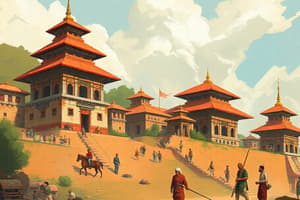Podcast
Questions and Answers
What was the vision of Prithvi Narayan Shah during the unification of Nepal?
What was the vision of Prithvi Narayan Shah during the unification of Nepal?
- A unified Nepal, strong and prosperous, like a yam between two boulders (correct)
- A theocratic state
- A strong and centralized government
- A federal system of government
What was the outcome of the People's Movement in 1990?
What was the outcome of the People's Movement in 1990?
- The establishment of a communist government
- The establishment of a multiparty democracy (correct)
- The adoption of a presidential system
- The overthrow of the monarchy
What was a characteristic of the Rana Rule in Nepal?
What was a characteristic of the Rana Rule in Nepal?
- A federal system with a strong parliament
- A system of governance based on Buddhist principles
- Isolationism and suppression of democracy (correct)
- A decentralized system of government
What was a notable feature of the Malla Period in Nepal's history?
What was a notable feature of the Malla Period in Nepal's history?
What was a characteristic of the Licchavi Dynasty in Nepal's history?
What was a characteristic of the Licchavi Dynasty in Nepal's history?
Who was a key figure during the unification of Nepal?
Who was a key figure during the unification of Nepal?
What was the outcome of the People's Movement in 1991?
What was the outcome of the People's Movement in 1991?
What was a key feature of the Rana Rule in Nepal?
What was a key feature of the Rana Rule in Nepal?
What was a notable feature of the Malla Period in Nepal's history?
What was a notable feature of the Malla Period in Nepal's history?
What was a characteristic of the Licchavi Dynasty in Nepal's history?
What was a characteristic of the Licchavi Dynasty in Nepal's history?
Flashcards are hidden until you start studying
Study Notes
Unification of Nepal
- Started in 1768 by Prithvi Narayan Shah, a Gorkhali king
- Unified various small kingdoms and principalities into a single nation
- Shah's vision: "A unified Nepal, strong and prosperous, like a yam between two boulders"
- Key battles: Nuwakot, Makwanpur, and Kirtipur
- Led to the formation of modern Nepal
Democratization
- Started in 1990 with the People's Movement (Jana Andolan)
- King Birendra was forced to accept a constitutional monarchy
- Multiparty democracy was established, ending the Panchayat system
- Key figures: Ganesh Man Singh, Krishna Prasad Bhattarai, and Girija Prasad Koirala
- Led to the adoption of a new constitution in 1991
Rana Rule
- Lasted from 1846 to 1951
- Rana prime ministers held absolute power, while the king remained a figurehead
- Key figures: Jung Bahadur Rana, Bir Shamsher, and Chandra Shamsher
- Characterized by:
- Modernization and infrastructure development
- Isolationism and suppression of democracy
- Favoritism and nepotism
Malla Period
- Lasted from 1200 to 1769
- Marked by the rise of city-states and the Malla dynasty
- Key cities: Kathmandu, Bhaktapur, and Patan
- Characterized by:
- Cultural and artistic achievements
- Trade and commerce with Tibet and India
- Competition and conflict among city-states
Licchavi Dynasty
- Lasted from 400 to 750 CE
- Marked by the rise of a powerful and prosperous kingdom
- Key figures: Mandeva, Amsuvarman, and Jayavarman
- Characterized by:
- Buddhism and Hinduism coexisted
- Trade and cultural exchange with India and China
- Development of art, architecture, and literature
Unification of Nepal
- Prithvi Narayan Shah, a Gorkhali king, initiated the unification of Nepal in 1768
- He unified various small kingdoms and principalities into a single nation
- Shah's vision was to create a "unified Nepal, strong and prosperous, like a yam between two boulders"
- Key battles that led to the unification include Nuwakot, Makwanpur, and Kirtipur
- The unification led to the formation of modern Nepal
Democratization
- The People's Movement (Jana Andolan) in 1990 led to the democratization of Nepal
- King Birendra was forced to accept a constitutional monarchy, ending the absolute monarchy
- A multiparty democracy was established, replacing the Panchayat system
- Key figures involved in the democratization process include Ganesh Man Singh, Krishna Prasad Bhattarai, and Girija Prasad Koirala
- The democratization led to the adoption of a new constitution in 1991
Rana Rule
- The Rana rule lasted from 1846 to 1951, during which Rana prime ministers held absolute power
- The king remained a figurehead during this period
- Key figures involved in the Rana rule include Jung Bahadur Rana, Bir Shamsher, and Chandra Shamsher
- The Rana rule was characterized by modernization and infrastructure development
- It was also marked by isolationism, suppression of democracy, and favoritism and nepotism
Malla Period
- The Malla period lasted from 1200 to 1769 and was marked by the rise of city-states and the Malla dynasty
- Key cities during this period include Kathmandu, Bhaktapur, and Patan
- The Malla period was characterized by cultural and artistic achievements
- It was also marked by trade and commerce with Tibet and India
- The period saw competition and conflict among city-states
Licchavi Dynasty
- The Licchavi dynasty lasted from 400 to 750 CE and was marked by the rise of a powerful and prosperous kingdom
- Key figures involved in the Licchavi dynasty include Mandeva, Amsuvarman, and Jayavarman
- The Licchavi dynasty was characterized by the coexistence of Buddhism and Hinduism
- It was also marked by trade and cultural exchange with India and China
- The period saw the development of art, architecture, and literature
Studying That Suits You
Use AI to generate personalized quizzes and flashcards to suit your learning preferences.




